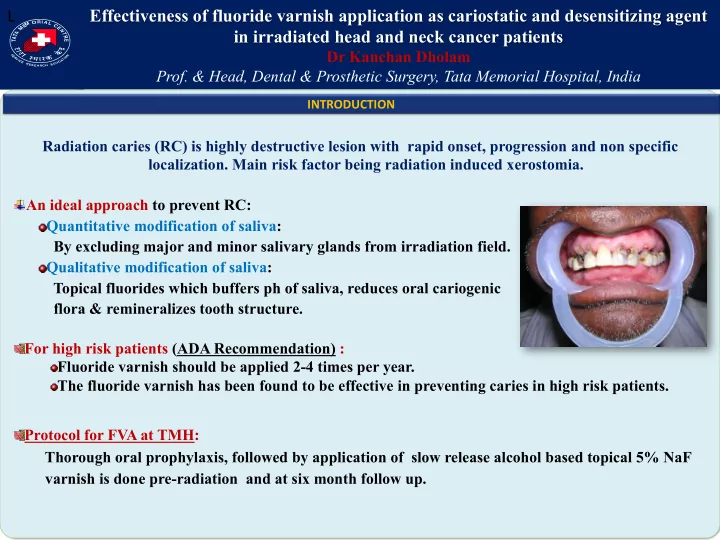

L" Effectiveness of fluoride varnish application as cariostatic and desensitizing agent " in irradiated head and neck cancer patients Dr Kanchan Dholam Prof. & Head, Dental & Prosthetic Surgery, Tata Memorial Hospital, India INTRODUCTION) Radiation caries (RC) is highly destructive lesion with rapid onset, progression and non specific localization. Main risk factor being radiation induced xerostomia. ! An ideal approach to prevent RC: ! Quantitative modification of saliva: By excluding major and minor salivary glands from irradiation field. ! Qualitative modification of saliva: Topical fluorides which buffers ph of saliva, reduces oral cariogenic flora & remineralizes tooth structure. ! For high risk patients (ADA Recommendation) : ! Fluoride varnish should be applied 2-4 times per year. ! The fluoride varnish has been found to be effective in preventing caries in high risk patients. ! Protocol for FVA at TMH: Thorough oral prophylaxis, followed by application of slow release alcohol based topical 5% NaF varnish is done pre-radiation and at six month follow up.
OBJECTIVES) ! To study the effect of fluoride varnish application on RC in HNC patients. ! To study the effect of fluoride varnish application on dental sensitivity in HNC patients. ! To assess the compliance of patients to three monthly fluoride varnish application (FVA). MATERIALS)AND)METHODS) ! 190 patients (138 males & 52 females) were randomly selected and reviewed. ! Patient’s demographics, tumor location, staging, histopathology, radiation dosage and surgery were recorded. ! The patients were divided into three groups depending on their radiation dose namely Group 1: < 50Gy, Group 2: 50- 60Gy and Group 3: >60Gy. ! Pre-radiotherapy and follow up decayed missing filled teeth index (DMFT), dental sensitivity, compliance to three monthly FVA was recorded till 15 months follow up. ! Statistical calculations were performed by using Mann Whitney U test or Kruskal Wallis test (as appropriate) for continuous variables and Chi-square test or Fisher’s exact test for categorical variables. RESULTS) Tumor site Histopathology Site of primary tumor ) No. of patients ) Type of primary tumor ) No. ) ) Oral cavity ) 108 ) Squamous cell carcinoma ) 156 ) Oropharynx ) 35 ) Salivary gland tumor ) 15 ) Salivary glands ) 12 ) Para nasal sinus ) 20 ) Undifferentiated carcinoma ) 04 ) 33 ) Others (Larynx, Nasopharynx, Others ) 15 ) Unknown primary) )
RESULTS) Treatment DMFT index B e f o r e 3 6 9 1 2 1 5 No. of % of Patients Radiation RT ) Months ) Months ) Months ) Months ) Months ) patie Dose Radiotherapy ± Chemotherapy Mean ) 4.12 ) 4.28 ) 4.46 ) 4.83 ) 5.04 ) 5.14 ) nts Radiotherapy+ Surgery ± Chemotherapy SD ) 4.35 ) 4.42 ) 4.85 ) 5.15 ) 5.31 ) 5.36 ) Group 1: 10 Max. ) 32 ) 32 ) 32 ) 32 ) 32 ) 32 ) < 50Gy Min. ) 0 ) 0 ) 0 ) 0 ) 0 ) 0 ) Group 2: 28% 95 p value ) .188 ) .725 ) .028 ) .003 ) .002 ) 50-60Gy DMFT across the study period with respect to: Group 3: 36 72% >60Gy Sex & Surgery ) Statistically not significant (p = .952, .107). ) ! Radiation Site of disease & " dose not 49 Statistically significant (p = .038, .015). " known Radiation dose Dental Sensitivity Compliance to FVA Radiation caries Caries incremental rate ! Pre-radiotherapy to six months- 1.34/month (8.02%) ! Six months to fifteen months – 1.71/month (15.35%) ! Pre-radiotherapy to fifteen months - 1.64/month (24.6%). CONCLUSION) ! Radiation caries is the late effect of radiotherapy. ! Effective alternative to daily fluoride gel application ! Though compliance with 3 monthly FVA is good, there is still a ! Three monthly FVA helps in decreasing the incidence of RC. need to educate and reinforce these patients about need of FVA. ! It also helps in decreasing the radiation induced dental sensitivity.
Recommend
More recommend